Sustainable Diamonds

Leonardo DiCaprio is almost as famous for his environmental activism as his movies. In 1996, he starred in ‘Blood Diamond’ - a film that influenced the creation of the sustainable diamonds industry.
A lot of good came out of that movie, set in the artisanal diamond fields of Sierra Leone during its decades-long civil war.
The conflict stopped and investment came back. A global rough diamond tracking system called the Kimberley Process was launched, regulating flows from all producer nations.
It created a growing market for sustainable, ethically mined conflict-free diamonds that are kinder to the planet and better for miners, and boosted the market for lab grown diamonds.
But how do real, sustainable diamonds compare to lab grown diamonds or cubic zirconia, and how can buyers be 100% sure the diamond in the perfect piece they’ve spotted in a shop window is sustainable? Settle back and read on.
A brief history of diamonds
Natural diamonds are formed over 100 miles below the earth’s crust, where carbon is subjected to extremely high temperature and high pressure. They were blasted to the surface during periods of continent building millions of years ago by special types of deep volcanism.
From India to South Africa
In the 4th Century BC ancient Indian texts refer to diamond’s supernatural hardness, and culturally it became prized as a mighty stone, fit for kings. As trade in diamonds grew along the Silk Road in early history, right up to the 18th Century India was believed to be the world’s only source of diamonds until the 18th century, when sources began to be depleted after extensive mining.
The search was on for more diamonds, and in 1725 newly discovered diamond deposits in Brazil fed global demand.
The beginnings of the industry dates back to 1866, when teenager Erasmus Jacobs happened across an eye catching pebble on the bank of the Orange River in South Africa, which turned out to be a 21.25-carat diamond.
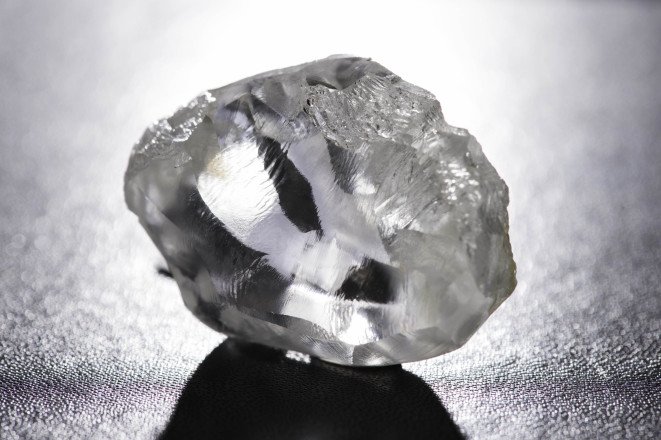
Rough natural gem diamond. Image courtesy of Petra Diamonds
Five years later, a colossal 83.50-carat gem was discovered on a nearby farm, which sparked a rush of prospectors to the region. Soon a chaotic landscape caused by individual claims pitted the landscape, and the town of Kimberley grew up nearby.
Diamonds go global
By 1880, Cecil John Rhodes consolidated the mines into one business, the De Beers Consolidated Mines Company, to control the flow and market of natural, real diamonds. However, diamonds lost their sparkle after the impact of World War I on the fortunes and lifestyles of wealthy Western Europeans, who were the main consumers of diamonds.
By 1919, their value had almost halved, and their slump continued again due to World War II but all was not lost. In 1947, leading US advertising agency N.W. Ayer were commissioned to create a large-scale campaign to make the diamond the go-to stone for engagement rings aimed at the vast, newly emerging American middle class.
The timeless slogan ‘a diamond is forever’ was born, and the industry has barely looked back since.
Saying ‘I do’ with a natural diamond
Rings to signify status and property ownership have been worn since early Egyptian times. In the West, the engagement ring has been around since Roman times and were more commonly known as betrothal or ‘truth’ rings.
But the first ever diamond engagement ring might be a uniquely individual ring, beautifully set with diamonds in the shape of the letter M, given by Archduke Maximilian of Austria to his beloved Mary of Burgundy in 1477.
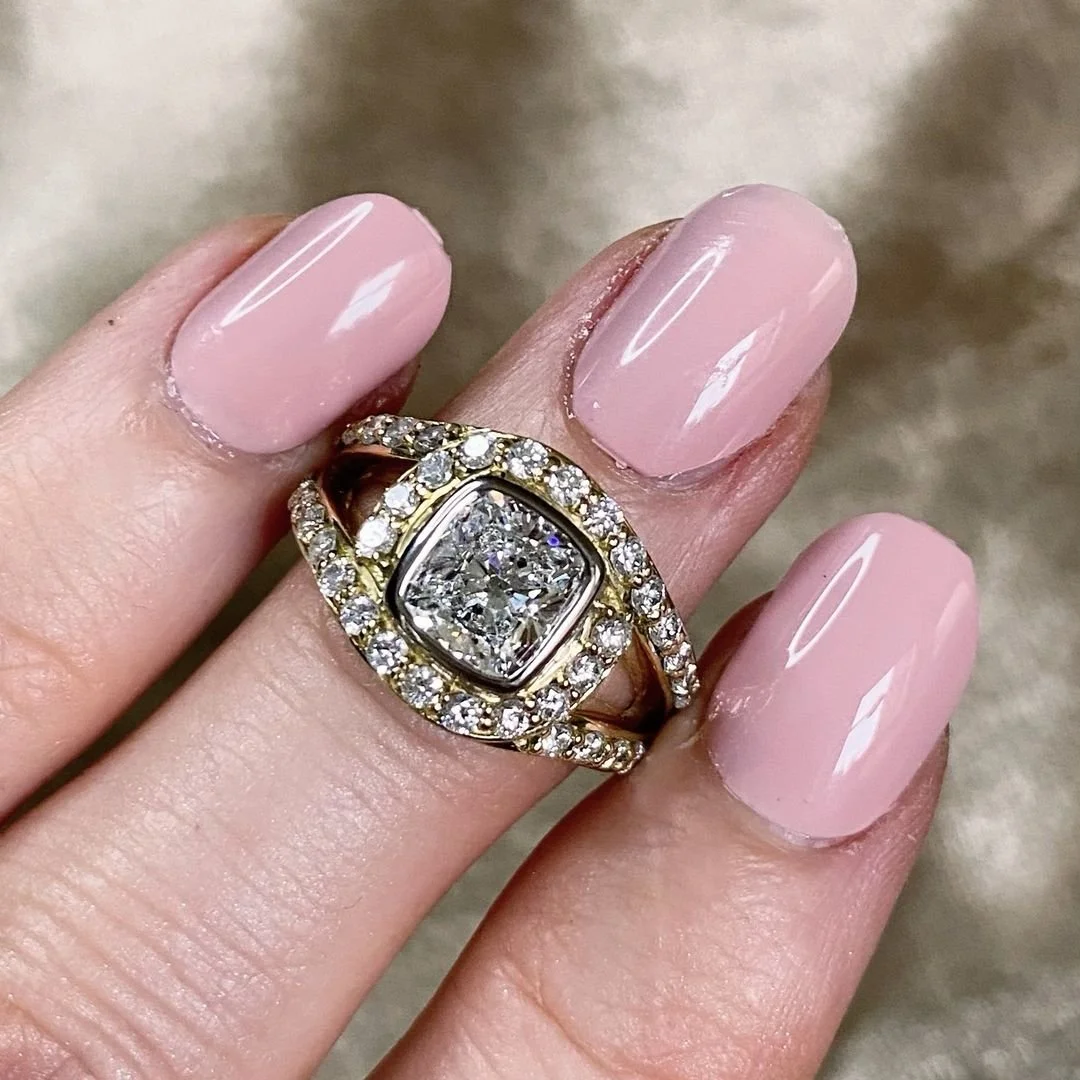
Cushion shape, ethically sourced diamond in a lovers’ knot design bespoke engagement ring. Image: Jessica May Jewels
Although betrothal rings were worn in Europe by this time, diamonds were rare and reserved for royalty or the very wealthiest people. Now, all around the world, young couples aspire to seal their love with a glittering, precious stone - the classic diamond ring.
More than just a pretty face
Did you know only around 30% of all mined diamonds are gem quality? The other 70%, known in the trade as boart is sold to industrial customers.
The reason for that is twofold: optical characteristics and physical properties. Diamond is the hardest substance on earth (its name comes from the Greek word adamas, meaning “unconquerable”), and it has the highest thermal conductivity of any material at room temperature. That makes it extremely useful for industry, technology, specialist equipment and optics, perfect for lab diamonds.
The lab grown diamond: all that glitters…
While natural diamonds have delighted and inspired people for hundreds of years, it’s fair to say the diamond mining business has not.
De Beers was convicted of price fixing over decades of monopolising a global cartel. Consumers were further turned off the diamond mining industry by awful stories of human rights atrocities in Marange, Zimbabwe, images of half-naked artisanal child miners sluicing bowls of dirty river gravel under the blazing sun, soil erosion, not to mention the giant scars in the earth of vast, open-pit mines that are visible from space.
They went looking elsewhere for ethical alternatives to blood diamonds, and diamond look-a-like cubic zirconia and more recently, synthetic laboratory grown diamonds, appeared perfect alternatives.
A real, ethical alternative?
The mined diamond industry crystallised (if you’ll pardon the pun) three of modern consumers biggest current concerns: carbon emissions from the use of fossil fuels, ecological harm to the Earth, including air pollution, and unethical mining practices that abused or negatively impacted human rights.
Lab grown diamonds were packaged as a conflict free, environmentally friendly, ethical choice, with a low impact on the planet and rarely originating from war zones.
But scratch the surface and it’s soon clear there’s more to man-made, lab grown diamonds than meets the eye, and there’s far more to them than their conflict free diamond counterpart.
Lab grown diamonds: an energy intensive production process

Diamonds naturally develop over millions of years, and industrial factories where lab grown diamonds are made use vast amounts of electricity to power the high-pressure, high-temperature machinery and advanced technological processes required to replicate that process and create such incredibly dense crystals.
As the problem of climate change becomes even more acute, many companies and brands are turning to carbon credits to ‘pay off’’ the tons of extra CO2 they have pumped into our beleaguered atmosphere, for example by paying for trees to be planted.
You don’t have to be a maths wizard to understand the balance doesn’t quite work: trees take decades to grow and mature but the CO2 emissions are happening to the Earth now.
That means, compared to conflict free diamonds, lab grown diamonds aren’t quite as clean and green to create as they may seem.
Oversupply without demand?
Although the lion’s share of mined diamonds are for industrial use, the truth is we only actually need to manufacture a relatively small quantity of industrial diamonds - tiny, grit sized stones.
People don’t ‘need’ the larger lab grown diamonds grown in highly controlled laboratory environments and sold for jewellery at such a high cost in emissions.
Mining natural diamonds from the earth unearths all sizes for all uses at exactly the same carbon cost per crystal, large or small, so the bigger gem rough pays for the industrial stuff.
Improvements in renewable energy generation will enhance the carbon-footprint of lab grown diamonds but until then, what do we do?
Sustainable diamond mining
The world’s biggest manufacturer of lab grown diamonds is China - not a country known for its high ethical standards in upholding human rights, free speech and democracy.
The Democratic Republic of Congo is rife with corruption, obscurity, malpractice and child labour issues, requiring international audits in return for access to the global market.
In Russia, the world’s biggest economic supplier of rough diamonds provides a direct flow of cash for Putin to use as he sees fit, though that has been curtailed by sanctions imposed by the West after the Ukraine invasion.
Why buy emerging nations’ diamonds?
International trade can bring with it fairness and human rights, and emerging nations often have natural resources like diamonds, and low-skilled populations in need of a better future.
These are countries that need the stable economic investment that global trades such as diamonds bring, and the accompanying scrutiny and accountability in democracy, anti-corruption and human rights.
Success stories: Botswana and Sierra Leone
In Botswana, the poster child of diamond-producing nations, revenue from diamonds has built national infrastructure, educated a nation, equipped, and staffed universities and hospitals.
In Sierra Leone, the land that gave us the original blood diamond, is building a new path in ethical, artisanal mining via the pioneering GemFair project, in which community-led social enterprises operate their own sustainable diamond mining projects.
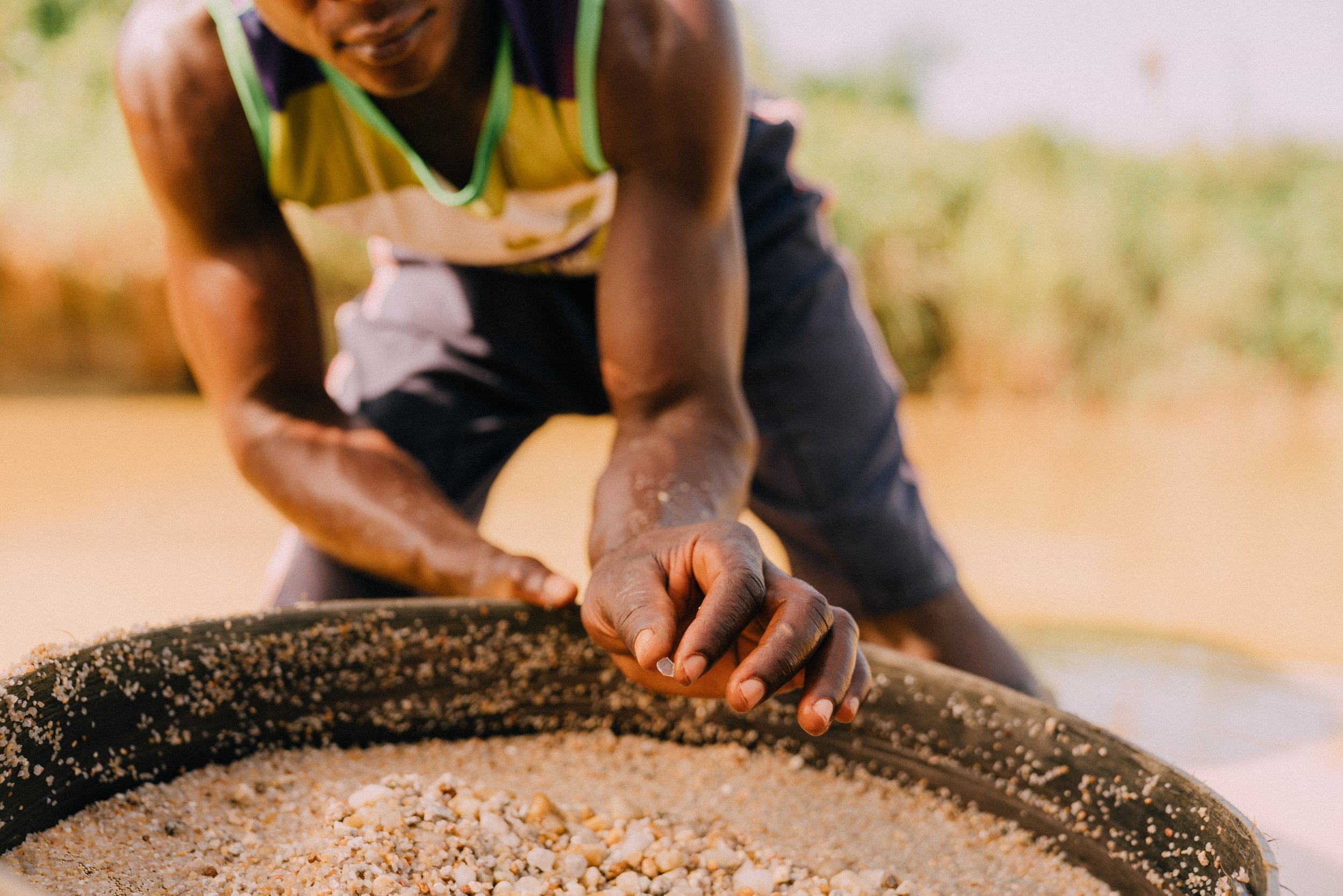
GemFair artisan mining in Sierra Leone, image courtesy of GemFair
They underpin a wide spectrum of national standards put in place by the diamond mining sector, including the System of Warranties that is the polished, cut diamond stone equivalent of the Kimberley Process that covers rough diamonds.
When you buy jewellery made with real diamonds, you will see the warranty statement printed at the bottom of your invoice. Lab created diamonds don’t have it.
Lab grown diamonds v natural diamonds v cubic zirconia
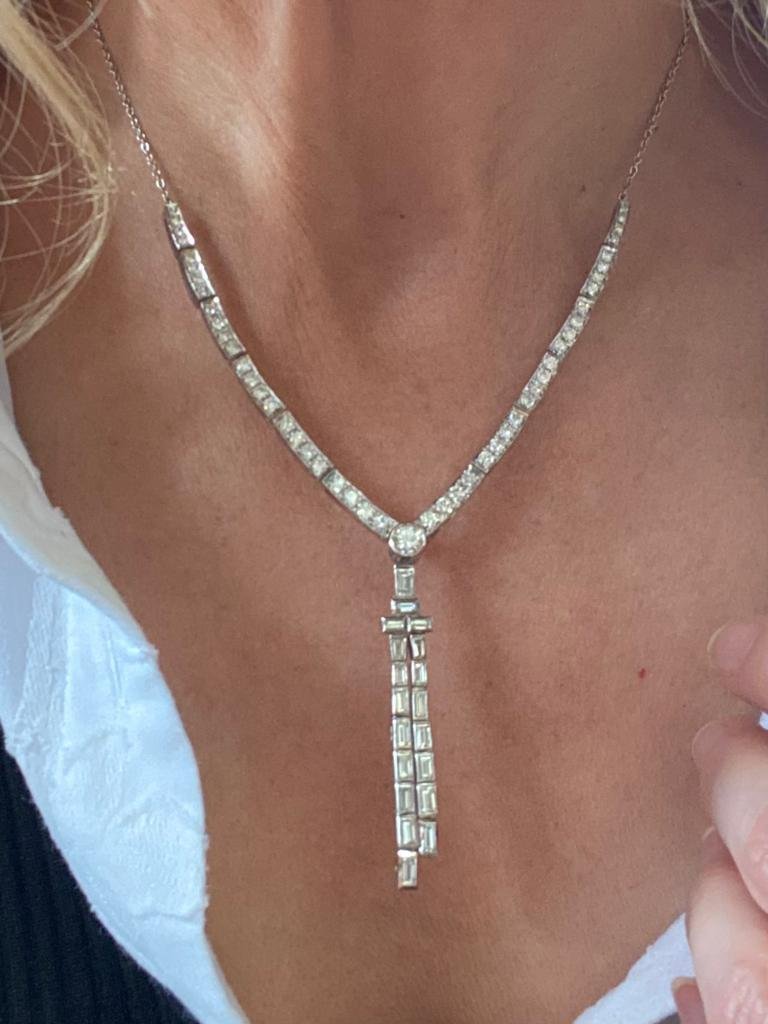
A recently completed transformation of an important period family diamond necklace into a contemporary necklace with detachable tassel. Image Jessica May Jewels.
Cubic zirconia is a synthetic gem that was first created in the 1970s. Production is very cheap and relatively easy and is a more convincingly dazzling diamond simulant than glass or paste stone. However, as a stone, it is soft and not durable, so it’s not a suitable choice for engagement rings which need to stand up to daily wear and tear.
The benefits of lab created diamonds are that they are much cheaper than their natural counterparts, just as dazzling, and just as durable.
The majority of lab grown diamonds and synthetic diamonds are created from a natural diamond seed, using the chemical vapour deposition method which, according to the Gemological Institute of America, is less costly and produces man made diamonds that look more like natural, mined stones.
However, there’s no resale value in man made diamonds, even the most sustainable lab grown diamonds won’t give you anything to show for your outlay post purchase.
A lab grown diamond will look attractive and may offer excellent value for money, but unlike a natural mined diamond, it doesn’t have the potential to support and help developing economies build their way to a better future.
What about recycled diamonds?
There’s something really magical about inheriting family jewellery with special stories from loved ones, but impossible to know the origin stories of those natural diamonds. But the very act of passing on something beautiful and precious to a new generation is a sustainable one, as it limits unethical production.
Using recycled diamonds and other stones is a fast-growing market, and my clients love the opportunity to create new, practical pieces from unused or unfashionable jewellery to adore wearing now, and pass on in the future.
Virtuous circles all round!
Fair trade and peace of mind
Sustainable real diamonds benefit local communities the most, have been traded fairly, cause least ecological harm and retain some value indefinitely.
This means the most thoughtful way to buy diamonds is to buy natural, from a designer like myself or brand with clear ethical policies you can fully understand, and if not, discuss with them.
My podcast, INSIDE THE JEWEL VAULT, features the great and good of the jewellery world, who share insights into conflict free diamonds and sustainable diamonds and best practise within the industry.
A crystal-clear supply chain for mined diamonds
Their gems will have come from a known supply chain network, in which every link passes on an ethical statement when a real diamond or parcel of ethical diamonds changes hands.
It means anyone browsing the web in the comfort of their own home, searching for that perfect engagement ring, can be 100% certain they’re buying ethically sourced diamonds, from companies that are striving to minimise their environmental impact on the Earth, whilst giving a hand up to others.
The most sustainable diamonds are schemes such as GemFair as they get underway. Meanwhile, It’s my advice to ensure you’re buying diamonds from brands that ultimately can trace their diamonds back to Debswana (from Botswana) or Canada.
Timeless beauty: the real appeal of sustainable diamonds
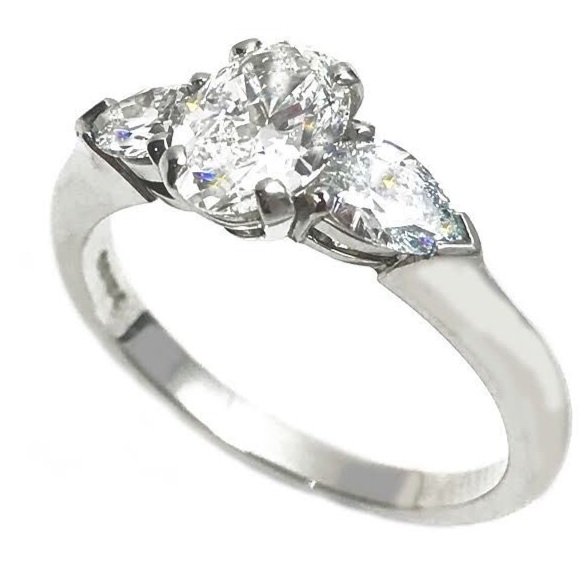
Bespoke oval and pear shape diamond engagement ring in platinum handmade mount. Image Jessica May Jewels.
How customers spend their money is always a personal choice, but the people I speak to really care about investing wisely when it comes to diamonds, no matter the size of their budget.
Excellent value for money comes not only from knowing a jewellery purchase is ethical and sustainable, but also the happiness that surfaces every time it is worn.
A bit of a stretch in spending can also pay off in the years ahead. Wearing that piece of diamond jewellery will always make you feel special, will always remind you that you’re worth it.
What better way to light up your life for years to come?
Whether you’re looking to use sustainable diamonds in a bespoke ring or want to breathe new life into your grandmother’s jewellery, I can help. Email me at jessica@jessicamayjewels.com or call +44 (0) 7879 413091, between 9am and 6pm, Monday to Saturday.

